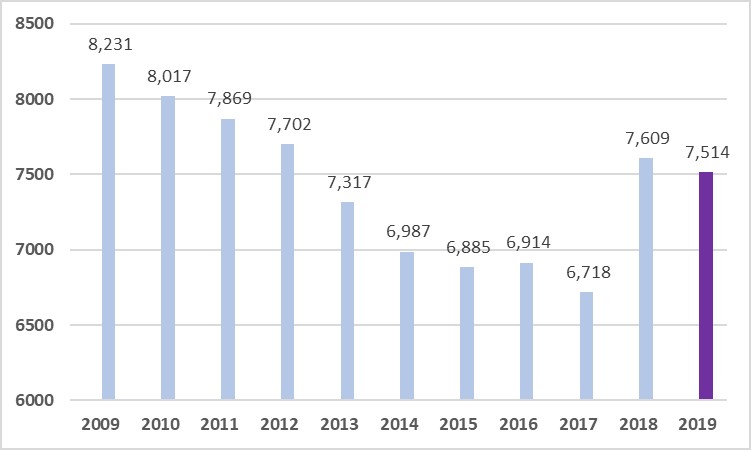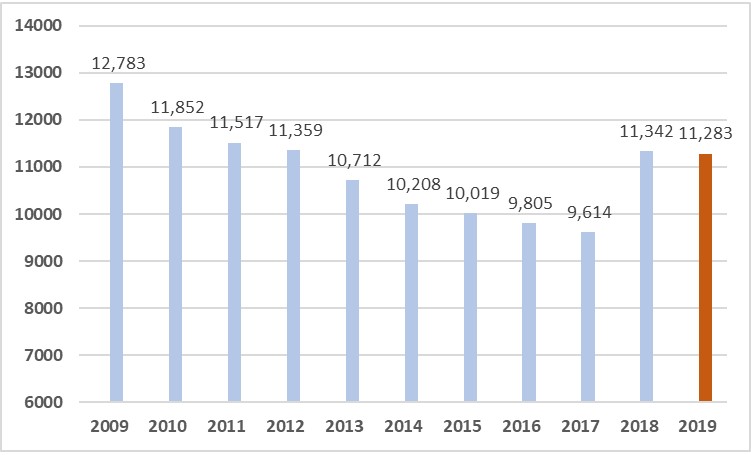On January 24, 2020, the U.S. Equal Employment Opportunity Commission disclosed its 2019 sexual harassment statistics. After a significant increase in sexual harassment charges in FY 2018, the EEOC reports a 1.2% decrease last year. Despite the year-over-year drop, 2019 still had the second-highest number of sexual harassment charges since 2012.
2018 Sexual Harassment Statistics
In Fiscal Year 2018, the EEOC received a total of 7,609 charges alleging harassment of a sexual nature. That represented more than a 13% increase in sexual harassment charges versus FY 2017. It was the first time the number of sexual harassment charges filed with the EEOC had increased in more than a decade.
FY 2019 EEOC Data
For the fiscal year ending September 30, 2019, the EEOC received 7,514 sexual harassment charges. This number represents 10.3% of all charges the agency received between October 2018 and September 2019.
The full break down of cases by nature of allegation follows:
- Retaliation: 39,110 (53.8% of all charges filed)
- Disability: 24,238 (33.4%)
- Race: 23,976 (33.0%)
- Sex: 23,532 (32.4%)
- Age: 15,573 (21.4%)
- National Origin: 7,009 (9.6%)
- Color: 3,415 (4.7%)
- Religion: 2,725 (3.7%)
- Equal Pay Act: 1,117 (1.5%)
- Genetic Information: 209 (0.3%)
(Total exceeds 100% because some charges allege multiple bases.)
Big Picture
It’s hard to tell whether the 2019 sexual harassment data indicate that the 2018 spike was an aberration. Another increase last year would not have been surprising, but a 1% drop after a 13% increase doesn’t suggest that sexual harassment is no longer a concern in U.S. workplaces. There were still many more sexual harassment charges filed with the EEOC in FY 2019 than in the five years preceding the launch of the #MeToo movement.
EEOC Sexual Harassment Charges

Full EEOC charge-filing statistics are available here.
State-Level Claims
Many states have their own employment discrimination statutes and state agencies who process sexual harassment complaints. Many of these state (and some local) agencies have worksharing agreements with the EEOC. Such agencies, known as Fair Employment Practices Agencies (FEPAs), typically cross-file complaints with the EEOC.
The EEOC reports annual data on total sexual harassment charges, including those filed directly with FEPAs. However, this data may not encompass all state and local sexual harassment complaints. Some cases do not get timely registered with the EEOC or may be encoded differently at the state and federal level, for example.
The EEOC reports a total of 11,283 sexual harassment charges in FY 2019, combining cases filed with the EEOC directly and those reported from FEPAs. Or only a half-of-a-percent decrease from FY 2018.
EEOC & FEPA Sexual Harassment Charges

An Ongoing Concern
With or without these statistics, it’s clear that workplace sexual harassment remains a problem and an area of focus for regulators. Many states are reviewing their sexual harassment laws and requirements regarding initiatives like policies and training. New York, for example, dramatically relaxed the burden of proof on employees in all workplace harassment cases through 2019 legislation (after imposing mandatory annual sexual harassment training for all employees the year before). The EEOC reports a 5.3% increase in sexual harassment complaints in New York in FY 2019 (including FEPA data).
No one wants their business to become part of these statistics. However, policies and training sessions can be only part of the solution. Employers must respond promptly and thoroughly to all allegations of harassment in the workplace. This includes addressing problematic behavior that has not reached the level of a formal complaint. Waiting to see if a situation gets is destined to be a failed strategy.

You must be logged in to post a comment.